by Valentina Biondini, art and literature amateur
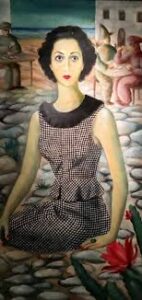
Nori (Eleonora) de’ Nobili is a painter and poet originatig of Marche, who spent half of her life in a mental hospital. Nori, the eldest of four children, was born in Pesaro in 1902 in a very wealthy family with whom she used to spend her childhood summers at the beautiful house known as “Villa Centofinestre” in Ripe, a small town in the province of Ancona.
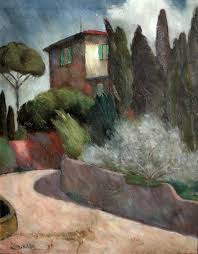
Her interest in art manifested itself from a very young age and the opportunity to cultivate and deepen it arose in 1924 when, with her whole family, she moved to Florence where she had the opportunity to attend, as a student, the studio of the Macchiaiolo painter Ludovico Tommasi. Two Macchiaiolo-style views such as Chiesa della Tosse and Casa sull’Arno belong exactly to this period. It was also in Florence that she met an art critic, Aniceto Del Massa, who helped her participate in the IV Mostra Regionale Toscana in 1930 and with whom she began a thwarted love affair, defined as a “passionate delirium”. It was precisely the disappointment in love, combined with the conflicts with her family that hindered her desire to emancipate herself from a destiny already written for a woman of the time, and also the premature death of her beloved brother Alberto to broke the psychological balance of a talented young woman, as intense as she was fragile, who had just opened up to life.
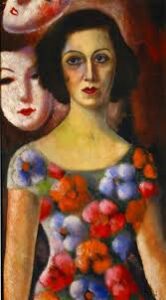
In 1935 her mental breakdown led her family to commit her to a clinic in Modena, a real mental asylum. Nori entered at the age of 33 and remained there for another thirty-three years, until her death on June 2, 1968. However, something unthinkable happened in the asylum, because here Nori devoted herself completely to poetry and painting. In fact, her economic comfort allowed her to have a room all to herself and to receive continuous supplies of colors and cultural magazines. Thus, within the walls of the nursing home, Nori wrote her autobiography in verse: «My soul is no longer inside me, but it has passed into seven hundred pages. Now it is all enclosed in the book. I am no longer me. It is the book, Nori. I am no longer Nori. The color of my being has passed from the pages».
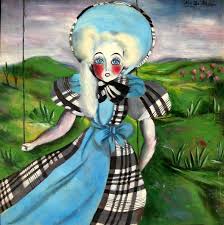
She also created over a thousand paintings in an expressionist style, almost naive at times, in which she denounced the hypocrisy of the historical period she lived through. And she created these works in every way and on every available surface: canvas, paper, the lid of a box, the cover of a notebook. So Nori worked every day to tell her suffering, in a sort of existential diary written with a brush, and she built an imaginary populated mainly by female figures, accompanied by clowns, gypsies, nurses, card players, musicians, cats and dolls. A fairy-tale and dreamlike universe where Nori is always the protagonist, she is portrayed with different clothes and poses. In these self-portraits the artist always sees herself as a different character: now a femme fatale, now a mask of the commedia dell’arte, as a tragic and melancholic figure.
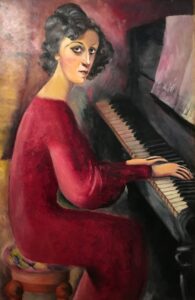
It is enough to observe works such as Nori al pianoforte (1943) or Nori in vestaglia a fiori (1950), to understand how hers was a silent and constant dialogue between herself and the canvas. The fixed gaze, the tense and anguished face, the recurring elements such as masks or fans, up to the static nature of the scene, everything refers to a blocked time and space, where the only possibility of salvation seems to be entrusted to the creative and mental universe of the artist herself. In fact, it almost seems like we can see her while, on a morning like all the others, she gets to work and thinks to herself: «I no longer need to live in the world or keep the window open to listen to the life that flows out there, the flow of existence reaches me between these thick walls, in the form of thoughts that my hands transpose onto the canvas. And then all the life that stirs inside me – denied, segregated by the hypocrisy of this cruel time of mine – becomes a riot of colors, games, celebration. I almost seem to hear the sound of it, the sound of life that expresses itself freely, without bonds or conventions or constraints. And it’s this art of mine that makes me feel free, beyond all material barriers and beyond all moral prejudices that cage the human race. And you, out there, are you really sure you are free?».
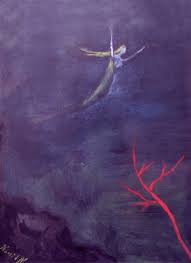
In 1967 she painted her last painting, L’anima di Nori che sale in cielo, on an X-ray plate, in which she seems to foretell and imagine her death, which will occur the following year. Nori’s tormented life and her immense artistic production appear as the plastic test of how art can become a tool to fight the pain. Nori was a sensitive, refined, visionary artist. A woman who was never tamed, and with her incessant work she demonstrated that her hypersensitivity, chromatic research and her stylistic language aren’t at all the fruit of madness. Her writings and paintings are timeless and are the key that allowed her to find within herself the liberation from the constraints imposed on her by society. On 7 October 2012, the Nori de’ Nobili Museum was inaugurated in Ripe, the village of his carefree childhood, which houses the artist’s historical archive and approximately 70 paintings that retrace her tormented and prosperous existence.